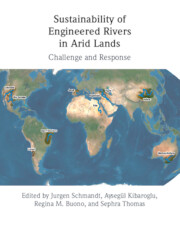Book contents
- Sustainability of Engineered Rivers in Arid Lands
- Sustainability of Engineered Rivers in Arid Lands
- Copyright page
- Dedication
- Contents
- Contributors
- Part I Introduction
- Part II Challenge
- 2 Global Climate Change and the Rivers
- 3 Reservoirs
- 4 Depletion of Groundwater
- 5 Endangered Food Security
- 6 Declining Environmental Flows
- Part III Engineered Rivers
- Part IV Response
- Part V Conclusion
- Index
- References
4 - Depletion of Groundwater
The Surface–Groundwater Connection
from Part II - Challenge
Published online by Cambridge University Press: 16 September 2021
- Sustainability of Engineered Rivers in Arid Lands
- Sustainability of Engineered Rivers in Arid Lands
- Copyright page
- Dedication
- Contents
- Contributors
- Part I Introduction
- Part II Challenge
- 2 Global Climate Change and the Rivers
- 3 Reservoirs
- 4 Depletion of Groundwater
- 5 Endangered Food Security
- 6 Declining Environmental Flows
- Part III Engineered Rivers
- Part IV Response
- Part V Conclusion
- Index
- References
Summary
This chapter explores the connection between groundwater and surface water. This is an important, but often overlooked, component of managing engineered rivers in arid lands. In order to make good management decisions, decision makers must understand the composition of water supplies and hydrological connections at work in their basin, including what portion of the overall water budget is supplied by groundwater, both in terms of availability and usage. Data gaps may impede this understanding in certain river basins. Directing policy and resources to meeting this information need should be a key priority.
- Type
- Chapter
- Information
- Sustainability of Engineered Rivers In Arid LandsChallenge and Response, pp. 46 - 56Publisher: Cambridge University PressPrint publication year: 2021

